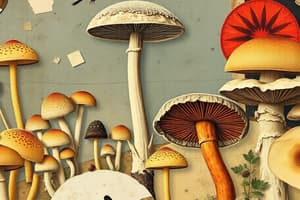Podcast
Questions and Answers
What is the primary focus of biology as a field of study?
What is the primary focus of biology as a field of study?
- The study of chemical reactions in a lab
- The study of stars and planets
- The study of rocks and minerals
- The study of life and living organisms (correct)
Which of the following is a characteristic of living organisms?
Which of the following is a characteristic of living organisms?
- Absence of metabolism
- Lack of response to stimuli
- Inertness
- Reproduction (correct)
What does 'biodiversity' refer to?
What does 'biodiversity' refer to?
- The variety of life on Earth (correct)
- The study of viruses
- The structure of the Earth
- The study of cells
Which of the following describes the science of classifying organisms?
Which of the following describes the science of classifying organisms?
Which of the following is the basic unit of classification?
Which of the following is the basic unit of classification?
Who proposed the five-kingdom classification?
Who proposed the five-kingdom classification?
Which kingdom includes prokaryotic, unicellular organisms?
Which kingdom includes prokaryotic, unicellular organisms?
Which kingdom contains eukaryotic, multicellular organisms with cell walls made of chitin?
Which kingdom contains eukaryotic, multicellular organisms with cell walls made of chitin?
Which kingdom includes eukaryotic, multicellular, heterotrophic organisms that lack cell walls?
Which kingdom includes eukaryotic, multicellular, heterotrophic organisms that lack cell walls?
Which of the following is NOT included in the five-kingdom classification?
Which of the following is NOT included in the five-kingdom classification?
Flashcards
What is Biology?
What is Biology?
The study of life and living organisms.
Growth
Growth
Increase in mass and the number of cells.
Reproduction
Reproduction
Production of new individuals.
Metabolism
Metabolism
Signup and view all the flashcards
Consciousness
Consciousness
Signup and view all the flashcards
Cellular Organization
Cellular Organization
Signup and view all the flashcards
Biodiversity
Biodiversity
Signup and view all the flashcards
Taxonomy
Taxonomy
Signup and view all the flashcards
Systematics
Systematics
Signup and view all the flashcards
Taxonomic Hierarchy
Taxonomic Hierarchy
Signup and view all the flashcards
Study Notes
No new information was added, so the study notes are the same.
- Biology is the study of life and living organisms.
Characteristics of Living Organisms
- Growth: Increase in mass and number of cells.
- Reproduction: Production of new individuals.
- Metabolism: Sum total of all chemical reactions occurring in the body.
- Consciousness: Awareness of the surroundings.
- Cellular organization: Living organisms are made up of cells.
Biodiversity
- Biodiversity refers to the variety of life on Earth, including genetic, species, and ecosystem diversity.
- Need to study variety of living organisms and their classification.
Taxonomy
- Taxonomy is the science of classification of organisms.
- Systematics: Study of evolutionary relationships between organisms.
Taxonomic Hierarchy
- Kingdom, Phylum/Division, Class, Order, Family, Genus, Species.
- Species is the basic unit of classification.
Five Kingdom Classification
- Proposed by R.H. Whittaker (1969).
- Monera, Protista, Fungi, Plantae, Animalia.
- Main criteria for classification include cell structure, body organization, mode of nutrition, reproduction, and phylogenetic relationships.
Kingdom Monera
- Includes bacteria, archaea, and cyanobacteria (blue-green algae).
- Bacteria are prokaryotic, unicellular organisms.
- Modes of nutrition: autotrophic or heterotrophic.
- Examples: Escherichia coli, Streptococcus.
Kingdom Protista
- Includes unicellular eukaryotic organisms.
- Examples: Protozoans, algae (e.g., diatoms, dinoflagellates).
- Modes of nutrition: autotrophic or heterotrophic.
Kingdom Fungi
- Includes eukaryotic, multicellular (except yeast) organisms.
- Cell wall made of chitin.
- Modes of nutrition: heterotrophic (saprophytic or parasitic).
- Examples: Mushrooms, molds, yeast.
Kingdom Plantae
- Includes eukaryotic, multicellular, photosynthetic organisms.
- Cell wall made of cellulose.
- Examples: Mosses, ferns, conifers, flowering plants.
Kingdom Animalia
- Includes eukaryotic, multicellular, heterotrophic organisms.
- Lack cell walls.
- Examples: Invertebrates (e.g., insects, worms) and vertebrates (e.g., fish, amphibians, reptiles, birds, mammals).
Viruses
- Not included in the five-kingdom classification.
- Acellular, infectious agents.
- Composed of nucleic acid (DNA or RNA) and a protein coat (capsid).
- Reproduce only inside a host cell.
Biological Classification
- Artificial systems: Based on easily observable characters.
- Natural systems: Based on natural affinities.
- Phylogenetic systems: Based on evolutionary relationships.
Morphology of Flowering Plants
- Root, stem, leaf, inflorescence, flower, fruit, and seed.
Root
- Types: Taproot, fibrous root, adventitious root.
- Functions: Absorption of water and minerals, anchorage, storage, synthesis of plant growth regulators.
Stem
- Functions: Support, conduction, storage, protection, vegetative propagation.
Leaf
- Functions: Photosynthesis, transpiration.
- Parts: Leaf base, petiole, lamina.
- Types: Simple, compound.
- Venation: Reticulate, parallel.
Inflorescence
- Arrangement of flowers on the floral axis.
- Types: Racemose, cymose.
Flower
- Parts: Calyx, corolla, androecium, gynoecium.
- Aestivation: Valvate, twisted, imbricate, vexillary.
- Placentation: Marginal, axile, parietal, free central, basal.
Fruit
- Developed from the ovary after fertilization.
- Parts: Pericarp (epicarp, mesocarp, endocarp) and seed(s).
- Types: Simple, aggregate, composite.
Seed
- Parts: Seed coat, cotyledons, embryo axis.
- Types: Dicotyledonous, monocotyledonous.
Plant Families
- Fabaceae (legume family), Solanaceae (potato family), Liliaceae (lily family).
Anatomy of Flowering Plants
- Tissues: Meristematic and permanent.
- Meristematic: Apical, lateral, intercalary.
- Permanent: Simple (parenchyma, collenchyma, sclerenchyma) and complex (xylem, phloem).
Tissue System
- Epidermal, ground, vascular.
Anatomy of Root, Stem, and Leaf
- Dicot and monocot.
Animal Tissues
- Epithelial, connective, muscular, neural.
Epithelial Tissue
- Covering or lining tissue.
- Types: Squamous, cuboidal, columnar, ciliated, glandular.
Connective Tissue
- Supports and connects other tissues.
- Types: Loose (areolar, adipose), dense (tendons, ligaments), specialized (cartilage, bone, blood).
Muscular Tissue
- Responsible for movement.
- Types: Skeletal, smooth, cardiac.
Neural Tissue
- Controls and coordinates body activities.
- Neurons and neuroglia.
Morphology of Animals
- Earthworm, cockroach, frog.
Cell: The Unit of Life
- Cell theory: Schleiden and Schwann.
- Cell structure: Prokaryotic and eukaryotic.
- Prokaryotic cell: Bacteria, mycoplasma, PPLO.
- Eukaryotic cell: Protists, fungi, plants, animals.
Cell Membrane
- Composition: Lipids, proteins, carbohydrates.
- Fluid mosaic model.
- Functions: Transport, cell signaling.
Cell Wall
- Plants: Cellulose.
- Bacteria: Peptidoglycan.
- Fungi: Chitin.
Cell Organelles
- Endoplasmic reticulum (ER): Smooth and rough.
- Golgi apparatus.
- Lysosomes.
- Vacuoles.
- Mitochondria.
- Plastids: Chloroplasts, chromoplasts, leucoplasts.
- Ribosomes.
- Cytoskeleton.
- Cilia and Flagella.
- Centrosome and Centrioles.
- Nucleus.
Biomolecules
- Carbohydrates: Monosaccharides, disaccharides, polysaccharides.
- Proteins: Amino acids, peptides, polypeptides.
- Lipids: Fatty acids, glycerol, triglycerides, phospholipids.
- Nucleic acids: DNA and RNA.
- Enzymes.
Cell Cycle and Cell Division
- Cell cycle: Interphase, M phase.
- M phase: Mitosis and meiosis.
- Mitosis: Prophase, metaphase, anaphase, telophase.
- Meiosis: Meiosis I and meiosis II.
- Significance of mitosis and meiosis.
Transport in Plants
- Means of transport: Diffusion, facilitated diffusion, active transport.
- Plant-water relations: Water potential, osmosis, plasmolysis, imbibition.
- Long distance transport of water: Water movement up a plant.
- Transpiration: Process and significance.
- Phloem transport: Source to sink.
Mineral Nutrition
- Essential mineral elements.
- Macronutrients and micronutrients.
- Role of macronutrients and micronutrients.
- Deficiency symptoms.
- Nitrogen cycle.
Photosynthesis in Higher Plants
- Photosynthetic pigments.
- Light reaction (photochemical phase).
- Dark reaction (biosynthetic phase or Calvin cycle).
- C4 pathway.
- Photorespiration.
- Factors affecting photosynthesis.
Respiration in Plants
- Glycolysis.
- Krebs cycle.
- Electron transport system (ETS).
- Aerobic and anaerobic respiration.
- Respiratory quotient (RQ).
Plant Growth and Development
- Growth regulators: Auxins, gibberellins, cytokinins, ethylene, abscisic acid.
- Photoperiodism.
- Vernalization.
Digestion and Absorption
- Human digestive system: Alimentary canal and digestive glands.
- Digestion of food: Mouth, stomach, small intestine.
- Absorption of digested products.
- Disorders of the digestive system.
Breathing and Exchange of Gases
- Respiratory organs in animals.
- Human respiratory system.
- Mechanism of breathing.
- Exchange of gases.
- Transport of gases.
- Respiratory volumes and capacities.
- Disorders of the respiratory system.
Body Fluids and Circulation
- Blood: Composition.
- Blood groups.
- Coagulation of blood.
- Lymph.
- Human circulatory system: Heart, blood vessels, circulation pathways.
- Cardiac cycle.
- Electrocardiogram (ECG).
- Disorders of the circulatory system.
Excretory Products and Their Elimination
- Modes of excretion: Ammonotelism, ureotelism, uricotelism.
- Human excretory system: Kidneys, ureters, urinary bladder, urethra.
- Urine formation.
- Function of the tubules.
- Regulation of kidney function.
- Disorders of the excretory system.
Locomotion and Movement
- Types of movement: Amoeboid, ciliary, flagellar, muscular.
- Human skeletal system: Bones and joints.
- Muscles: Structure of skeletal muscle, mechanism of muscle contraction.
- Disorders of the muscular and skeletal systems.
Neural Control and Coordination
- Neuron: Structure and types.
- Nerve impulse: Generation and conduction.
- Synaptic transmission.
- Central nervous system: Brain and spinal cord.
- Peripheral nervous system.
- Reflex action and reflex arc.
- Human eye and ear.
Chemical Coordination and Integration
- Endocrine glands and hormones.
- Human endocrine system: Hypothalamus, pituitary, pineal, thyroid, parathyroid, adrenal, pancreas, gonads.
- Mechanism of hormone action.
- Disorders due to hormonal imbalances.
Reproduction in Organisms
- Types of reproduction: Asexual and sexual.
- Asexual reproduction: Binary fission, budding, fragmentation, vegetative propagation.
- Sexual reproduction: Events (pre-fertilization, fertilization, post-fertilization).
Sexual Reproduction in Flowering Plants
- Pre-fertilization: Structure of flowers, microsporogenesis, megasporogenesis, pollination.
- Fertilization.
- Post-fertilization: Development of endosperm and embryo, formation of seed and fruit.
- Apomixis and polyembryony.
Human Reproduction
- Male reproductive system.
- Female reproductive system.
- Gametogenesis: Spermatogenesis and oogenesis.
- Menstrual cycle.
- Fertilization and implantation.
- Pregnancy and embryonic development.
- Parturition and lactation.
Reproductive Health
- Problems and strategies.
- Population explosion and birth control.
- Medical termination of pregnancy (MTP).
- Sexually transmitted diseases (STDs).
- Infertility and assisted reproductive technologies (ART).
Principles of Inheritance and Variation
- Mendel's laws of inheritance.
- Inheritance of one gene and two genes.
- Chromosomal theory of inheritance.
- Linkage and crossing over.
- Sex determination.
- Genetic disorders: Mendelian and chromosomal.
Molecular Basis of Inheritance
- DNA: Structure.
- DNA packaging.
- DNA replication.
- Transcription.
- Genetic code.
- Translation.
- Gene expression and regulation.
- Human genome project (HGP).
- DNA fingerprinting.
Evolution
- Origin of life.
- Theories of evolution: Lamarckism, Darwinism.
- Mechanism of evolution.
- Hardy-Weinberg principle.
- Types of natural selection.
- Human evolution.
Human Health and Disease
- Common human diseases: Infectious and non-infectious.
- Immunity: Types of immunity, immune system.
- AIDS, cancer, drug and alcohol abuse.
Strategies for Enhancement in Food Production
- Animal husbandry.
- Plant breeding.
- Single cell protein.
- Tissue culture.
Microbes in Human Welfare
- Microbes in household products, industrial production, sewage treatment, energy generation, biocontrol agents, biofertilizers.
Biotechnology: Principles and Processes
- Principles of biotechnology.
- Tools of recombinant DNA technology.
- Processes of recombinant DNA technology.
Biotechnology and Its Applications
- Biotechnology in agriculture: Genetically modified crops.
- Biotechnology in medicine: Insulin, gene therapy.
- Transgenic animals.
- Ethical issues.
Organisms and Populations
- Organisms and their environment.
- Populations: Population interactions, population growth.
Ecosystem
- Structure and function.
- Productivity.
- Decomposition.
- Energy flow.
- Ecological pyramids.
- Ecological succession.
- Nutrient cycles.
- Ecosystem services.
Biodiversity and Conservation
- Importance of biodiversity.
- Loss of biodiversity.
- Biodiversity conservation: In-situ and ex-situ.
Environmental Issues
- Air pollution and its control.
- Water pollution and its control.
- Solid waste management.
- Radioactive waste management.
- Greenhouse effect and global warming.
- Ozone depletion.
- Deforestation.
Studying That Suits You
Use AI to generate personalized quizzes and flashcards to suit your learning preferences.




